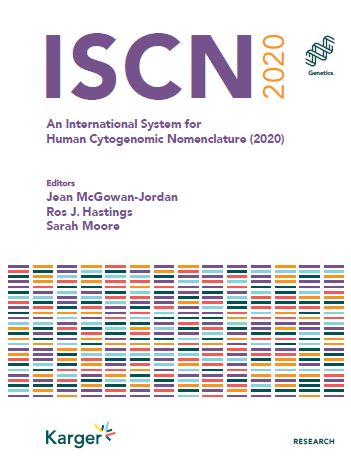ISCN Online is the digital companion to Karger’s Human Cytogenomic Nomenclature (ISCN 2020) book. This convenient and continuously up-to-date resource also adds value for readers by offering ways to interact with the scientists behind the nomenclature. One year after its market launch we can look back on this venture as a success.
The International System for Human Cytogenomic Nomenclature (ISCN) has earned its place next to thousands of microscopes in genetics labs since it was first published in 1963. Geneticists, molecular biologists, lab technicians, and students use it as an indispensable reference for standardized descriptions of anomalies of the human genome.
Working on the 2020 edition of ISCN, the editors and the standing committee, together with us as the publisher, resolved that it was high time to bring this established reference work online. Thus ISCN Online was born.

An International System for Human Cytogenomic Nomenclature (2020)
Three concepts, derived from a deep look into the needs and use cases of genetics professionals, were front and center during the design phase of the new platform: convenience, currency, and interaction.
Hyperlinks and Search Function
First, convenience. We knew from the outset that a book sitting next to the microscope, maybe with a lot of notes and bookmarks added over time, would be hard to beat in terms of usability. ISCN users tend to have “grown up” with the book, and many have perfected their use of it in their daily work over many years.
In the light of this, we focused on the things a printed book can’t easily do. On ISCN Online, users navigate an HTML version of the ISCN content with the table of contents constantly at their fingertips. All footnotes and references are hyperlinked. Alternatively, they can use a powerful search function to locate relevant parts effortlessly.
Second, currency. Genetics and genomics are rapidly evolving fields, with new concepts and techniques being added continuously. Given the typical period of 4-5 years between editions of the book, keeping ISCN more up-to-date through its digital companion was an obvious step to take. ISCN Online publishes addenda to the nomenclature at the right place in the originally published content of the book. This allows users to locate and understand these changes in their direct context and not miss any improvements in the parts of ISCN they work with most.
Interaction around the Globe
Also, no published book is free of mistakes. ISCN Online flags and corrects errata almost in real time and in their direct context. Moreover, in parallel to this and for a broader audience, errata are regularly published on a public web page and as a Free Access article in the Karger journal Cytogenetic and Genome Research.
Third, interaction. ISCN is a working tool for thousands of users out there. We want to make every effort to ensure the nomenclature serves them best. They may have questions regarding its use, and, even more importantly, they may have suggestions how to further develop and improve it. The ISCN Forum allows users to interact directly with the editors and the standing committee of ISCN as well as fellow users across the globe. As the online community grows, we are seeing more and more fruitful discussions happening, creating a win-win situation for the users and ISCN alike.
Each ISCN 2020 book comes with a unique code giving free and unlimited access to ISCN Online for one year after activation. This initial period can be extended in different ways once it expires. For individual users who want to use ISCN Online as a full replacement for the ISCN book, an online license is also available, covering the full period until the next version of ISCN is released – or much longer if users choose the perpetual license.
Digital Work Tools
One year in, we’re pleased with how the usage of ISCN Online has grown and especially with how the level of interaction is steadily increasing. Currently, the ISCN Forum and the addenda/errata published in their direct context seem to be more of a motivation to access ISCN Online than the content itself. This comes as no surprise, though, as the main use case for ISCN – having the book next to the microscope as a reference – is here to stay, and for good reasons. Its digital companion ISCN Online provides added value in terms of convenience, currency and interaction, giving users the best of both worlds.
In the future, ISCN Online will make the life of ISCN users even easier through the addition of digital work tools like a karyotyping builder/parser (already available in a beta version) and the integration of a similar tool covering the HGVS nomenclature that was recently added to the publication.
Stay tuned!






Comments
Share your opinion with us and leave a comment below!